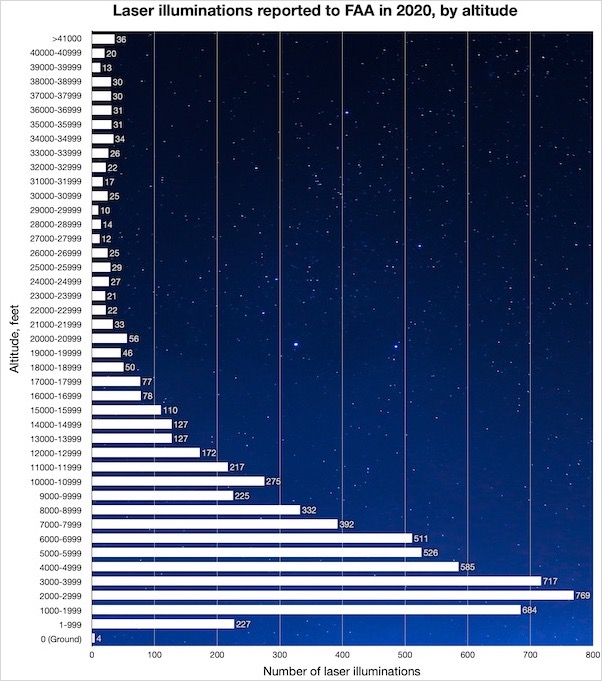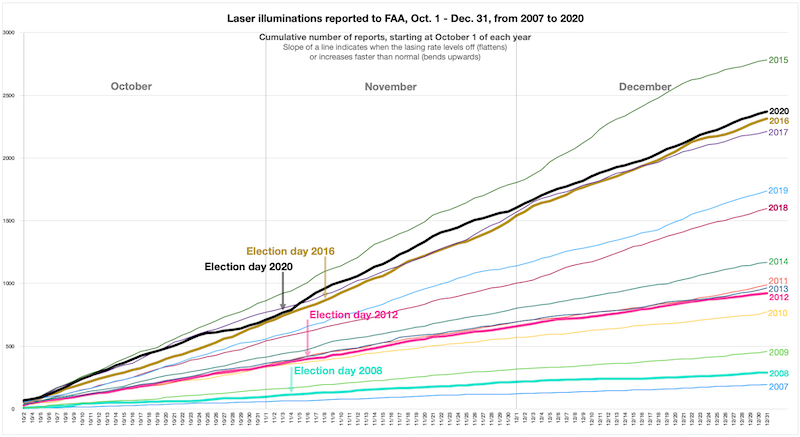Home
A comprehensive resource for safe and responsible laser use
Italy: Laser pointer used at Venice film festival to point out viewers without masks
"Mask-wearing was one of the most assiduously policed protocols; even mid-row offenders were publicly shamed by being immediately targeted with a red laser pointer, which must have felt like being in the sights of a sniper."
From the New York Times
COMMENTARY FROM LASERPOINTERSAFETY.COM
This is an interesting practical use for laser pointers. Of course ushers should only use a low-powered "bullet" type pointer like those sold in pet stores, that take two or three hearing-aid style batteries. Care should be taken to avoid the eyes. If the beam from a small Class 2 (less than 1 milliwatt) laser accidentally goes into a person's eyes, there would be a bright flash but no injury or damage.
US: 30 eye injuries May-July 2020 caused by police (not a laser)
The report focuses on kinetic impact projectiles (KIPs) such as so-called rubber bullets, baton bean-bag rounds, and tear gas canisters fired directly at protesters, journalists and bystanders. It specifically excludes chemical injuries such as from tear gas.
The effect of KIPs on the eye, according to the group, "nearly always causes total blindness in that eye, due to rupture of the globe (eyeball) as well as trauma to nearby structures."
The report notes that:
PHR’s database contains only incidents documented in traditional and social media. The tally depends on individuals to self-report their experiences, on journalists to identify and document injuries, or on the legal system to present these instances in the course of litigation. For these reasons, this count of injuries is believed to be only a fraction of the total number of people shot in the head and neck by U.S. law enforcement during the protests since May 2020….
In addition to the May 26 - July 27 2020 reports, the group also cited a "systematic review … of medical literature on kinetic impact projectiles over the past 25 years." This review found 1,925 injured people, 53 of whom died and 294 people with permanent disabilities. Further, "Permanent vision loss was the most common permanent disability."
The PHR report was cited in a May 20 2021 Narratively story (also published September 2 2021 at The Guardian) by photojournalist Wil Sands, whose right eye was blinded by a tear gas canister outside the White House on May 30 2020. Sands contacted others whose eyes were damaged by police using "less lethal weapons", told their stories, and has created an internet group for persons blinded by law enforcement.
Note: This story is part of our occasional coverage of eye injuries at protests which were not caused by a laser. This is because the number of actual or claimed laser eye injuries at protests (generally inflicted on police or security forces) is vastly outnumbered by actual or claimed eye injuries to protesters, journalists and bystanders (generally caused by police or security forces). In our view, no one should aim a laser or projectile at anyone's eye or head during protests, demonstrations and civil unrest.
US: FAA details fines since 2016 for laser strikes
Dickson noted that "if a person shines a laser at a plane, it can mean a fine of up to $11,000 for a single incident and up to $30,800 for multiple incidents."
He added, "Like many crimes, there is a need for education, outreach, and the cooperation from the public to address this safety risk. We encourage the public to report laser strikes to the FAA via our website or to your local law enforcement agency."
From the FAA video on YouTube
US: FAA webpage analyzes laser strike statistics
It includes graphs of yearly, monthly and daily laser event numbers, data on events by month and by day of the week, states ranked by raw numbers and on a per capita basis, injuries, and altitudes at which lasers were seen. By clicking on data points or sections of a chart, a box pops up with more precise information.
Here is the top part of the webpage as it appeared in September 2021:
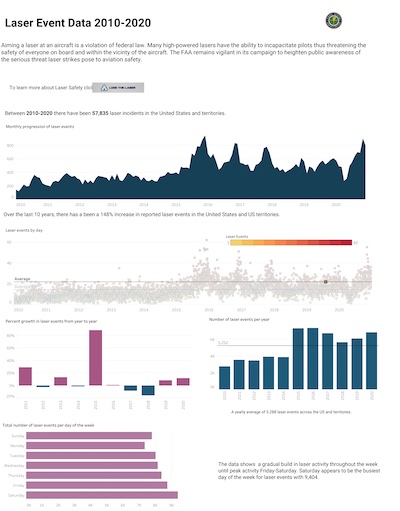
From FAA's data visualization webpage. If this link does not work, the data might also be accessed from FAA's main laser safety webpage. T
COMMENTARY FROM LASERPOINTERSAFETY.COM
Many of the FAA charts on the webpage are very interesting, such as the number of laser events per capita for each state. For example, Hawaii leads the country in laser illuminations per capita, in 2020.
However, some charts are near useless such as the "injuries" chart. This is organized by state, not by type of injury. Worse, there is no information provided about what counts as an injury, or the severity and outcome of the reported injury. (We have our own injury analysis chart on this page which is much more detailed.)
Another near-useless FAA chart is one that shows aircraft altitude during the incident. The chart shows data points with the number of flights at a given altitude. But there is no attempt to group altitude ranges together, for example, to find out how many laser incidents happened between 0-1000 ft, between 1000-2000 ft, etc. 
In contrast, this chart (done by LaserPointerSafety.com) has the same data formatted in a more understandable way:
US: New Missouri law makes it illegal to aim a laser pointer at a uniformed officer
A "laser pointer" is defined as a device that emits a visible light amplified by the stimulated emission of radiation.
The offense is a Class A misdemeanor.
From the "Revisor of Missouri" website page describing the new law
Canada: 236 reported laser strikes in 2020
In Canada, a person who intentionally interferes with an aircraft by using a laser faces a prison sentences of up to five years, and a fine of up to $100,000.
From CBC News. Additional examples of 2020 Canadian laser illuminations are in the story.
US: Air Force develops laser glare protection glasses for pilots
Washington State Patrol pilots successfully test special laser eye protection developed at Wright-Patterson Lab
Story by Mary Pacinda, Air Force Research Laboratory
Aiming a laser at an aircraft is a federal crime that can net offenders up to five years in jail or cost them a $250,000 fine. Even with this heavy potential penalty, laser strikes have become increasingly more common. According to the FAA, 6,852 such incidents were reported in 2020, compared with 385 in 2006, and so far this year, incidents of “joy lasing” are up 20 percent over last year. Cheap and easily obtained, hand-held lasers used as pointers and cat toys are certainly harmless when used as intended. But when they are aimed at the cockpit of an aircraft, they can temporarily blind the pilot — with possibly deadly consequences.
Laser strikes are almost always made at low altitudes when an aircraft is taking off or preparing to land — the two parts of flying that require the most attention from a pilot. Even if the beam of light does not hit the pilot’s eyes directly, it can cause a distraction or even raise an alarm that the plane may have become a target. In addition to the possible adverse effects of these human reactions, slight imperfections in the plane’s windscreen can cause the laser light to spread out, creating a glare that can temporarily obscure all vision inside the cockpit.
Of course, passing a law against any behavior — including pointing a laser at an airplane — seldom puts an end to the behavior. Thus, the best way to avoid disaster from laser strikes is to provide some sort of protection for the pilot. As a result, in recent years several manufacturers have developed laser eye protection (LEP) to meet a growing demand for help from military and law enforcement pilots. But this solution is not without problems of its own.
Most laser eye protection works by filtering out green or red light, the colors most commonly used in handheld lasers. Unfortunately, according to FAA studies and years of pilot experience, this can change the pilot’s ability to accurately read the instrument control panel. A 2019 FAA report suggested that this problem might be fixed by changing the type of lighting in the control panel.
Researchers at the Air Force Research Laboratory recently came up with a better solution, one that was successfully tested on the job by Washington State Patrol pilots.
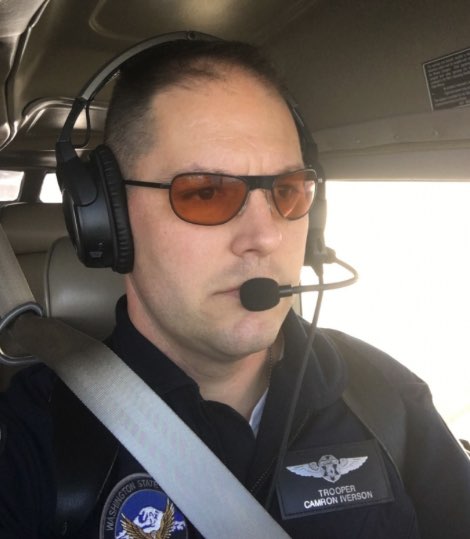
Flight Officer Camron Iverson of the Washington State Patrol tested laser protection lenses formulated at AFRL’s Materials and Manufacturing Directorate. (Photo by Mary Pacinda)
The Personnel Protection Team in AFRL’s Materials and Manufacturing Directorate, headed by Dr. Matthew Lange, used the cockpit compatibility design software developed for Department of Defense LEP and modified it for commercial use. The commercial version, called CALI (Commercial Aviation Low Intensity) filters out the laser light, but not the light coming from the pilot’s instrument panel. “Simply put,” said Lange, “the lenses maximize protection while minimizing the impact to the cockpit.”
US: Missouri bill proposes 1-year sentence for pointing laser at police
A number of persons representing doctors and police officers supported the bill. Even the lone person in opposition to the bill supported the general idea but thought that the penalty was too harsh.
On March 2 2021, the Standing Committee on Public Safety in executive session voted 10 to 0 in favor of the bill. It was referred to the Rules - Legislative Oversight committee for further action.
Bill text at the Missouri House of Representatives 101st General Assembly HB 31 webpage. Story from the News & Record, though it is difficult to tell whether the bill described in the story is this one or is HB280 which does not appear to include laser misuse in its text.
US: Charges dropped against protester accused of laser pointer assault
Yusuf Labib had been arrested in March 2021 at a memorial for Breonna Taylor on a charge with "assault with force likely to cause great bodily injury."
At a court hearing, the prosecutor said "in this instance the People do not believe the evidence shows beyond a reasonable doubt that Mr. Labib specifically intended to cause fear of bodily harm.”
She continued, “The police officer in this case personally knew colleagues who have suffered permanent eye damage from lasers being shined in their eyes, so they take this conduct very seriously…. The People request Mr. Labib recognize that these potential risks exist before choosing to use a laser pointer in the future.”
Labib told the judge that he heard the prosecutor's comments.
From the Davis Vanguard
NZ: Number of laser strikes on aircraft decreases, but may be due to flights decreasing
The March 2021 New Zealand data has been updated on the Laser/aircraft illumination statistics page. Scroll down to the "New Zealand" section. Also updated is the section comparing five countries including New Zealand.
The information was in a March 15 2021 email from CAA-NZ to LaserPointerSafety.com. The email noted that "Unfortunately our 2020 numbers were low primarily because our aircraft movements dropped so much due to Covid-19."
To look into this further, LaserPointerSafety.com estimated that in 2020 there were 273,000 airport movements (defined as a takeoff, landing or missed approach handled by Airways New Zealand). This compares with 1,023,000 movements in 2019 and a similar number in 2018.
Using this metric, in 2020 there were 256 laser illuminations per 1 million movements. This would be actually be a significant increase from the 2019 figure of 232 laser illuminations per 1 million movements.
Such a comparison may not be fully valid, however. The number of movements probably does not include flights by police and rescue aircraft. Because these are disproportionately targeted by laser perpetrators, a complete analysis would need to include such flights. It is not known if data are available.
Data from a March 15 2021 email from CAA-NZ. Thanks to Jenny Knowlsey for this data. Additional data on New Zealand aircraft movements is listed on the Laser/aircraft illumination statistics page under the "illuminations per 1 million flights" chart. Note that although "airport movements" are discussed above, on the statistics page this has been converted to "flights" by dividing the movements in half. This was done because "flights" is more understandable to the general public than "airport movements."
US: Why did lasers aimed at aircraft increase after the 2020 election?
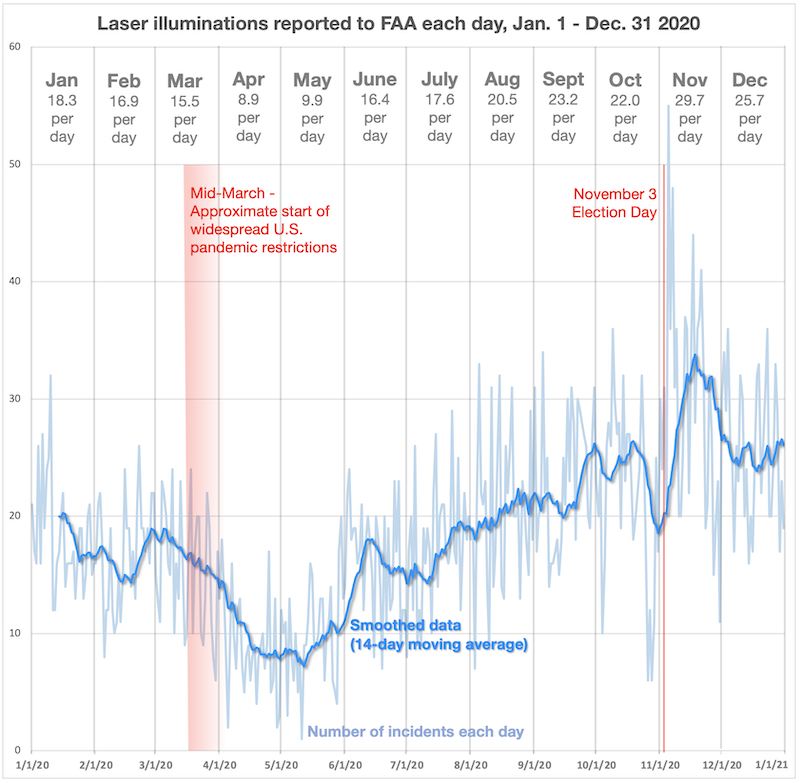
In fact, of the 10 highest days (most incidents) in 2020, all but one occurred in the Nov. 5-21 period. There were 55 incidents on Nov. 5, 48 on Nov. 6, 44 on Nov. 17, and 41 on Nov. 21. These occurred more than twice as often, compared with the 2020 average of 18.7 incidents per day.
Is this a statistical anomaly or did the disputed election results somehow lead to an increase in laser incidents?
COMMENTARY AND ANALYSIS BY LASERPOINTERSAFETY.COM
The chart below indicates that the three previous U.S. presidential elections did not have an effect on lasing incident rates.
It shows that in 2008, 2012, and 2016 the number of laser incidents each day between October 1 and Dec. 31 rose smoothly and steadily. In contrast, the lasing rate in 2020 (black line) slowed substantially around October 26, and rose significantly just after Election Day on November 3.
However, these two effects appear to counter each other. It may be that some other factor, such as how FAA records or processes laser incident reports, slowed in late October and sped back up in November.
In summary, while it is tempting to say that agitation over the 2020 election results led to an increase in persons aiming lasers at aircraft, this was not seen in previous election years and may be a statistical anomaly.
US: 6,852 laser illuminations reported to FAA in 2020
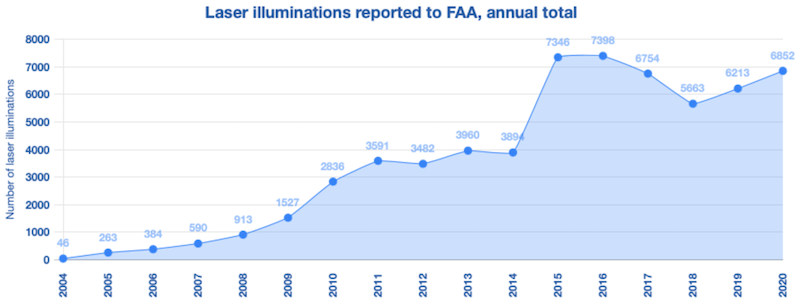
This means pilots saw lasers on average 18.7 times each day in 2020. However, the lasing rate was not evenly distributed. It reached a monthly low of about 9 illuminations per day in April 2020 — just as nationwide pandemic restrictions started. The highest rate was in November 2020, with almost 30 illuminations per day.

The peak number of illuminations, 55 on Nov. 5, occurred two days after the contentious 2020 election, when a presidential winner had not yet been declared. Of the 10 highest days (most incidents) in 2020, all but one occurred in the Nov. 5-21 period. A separate story at LaserPointerSafety.com discusses whether this is a coincidence or if there is some correlation with the election.
The charts above, and other detailed statistics, are on the Laser/aircraft illuminations statistics page. This includes data such as the following:
- The total number of U.S. laser/aircraft incidents since reporting to the FAA was mandated in 2004, is 61,712 as of Dec. 31, 2020.
- The total number of worldwide laser/aircraft incidents since 2004 is over 90,000. Only eight countries are included in this cumulative total, and many of these do not have data for some years in the 2004-2020 time period.
- Green laser light remains the most-reported. In 2020, 85.4% of incidents involved green light; blue was second with 9.2%. The number of blue lasers reported has steadily increased over the past few years. For example, in 2016 only 2.9% of incidents involved blue laser light.
- In 2020, only 0.3% of FAA-reported laser/aircraft incidents indicated that crew members suffered eye effects or temporary injuries. This rate has decreased since 2011, when 1.4% of incidents incurred eye effects or temporary injuries. The most-reported effects were flashblindness and/or afterimage; pain, burning or irritation; and blurriness.
US: Arizona law proposes stronger penalty for laser misuse during disorderly protests
Currently, this offense is a Class 1 misdemeanor. House Bill 2309, if passed, would make this a Class 6 felony if the "offense occurs in the course of committing violent or disorderly assembly."
A Class 6 felony is considered aggravated assault, with a mandatory minimum six month jail term.
"Violent or disorderly assembly" is a new term created in the bill, defined as follows: "A person commits violent or disorderly assembly if, with seven or more other persons acting together, the person, with the intent to engage in conduct constituting a riot or an unlawful assembly, causes damage to property or injury to another person."
As of February 24 2021, the bill was reported out of committee to the House.
From the Martinsville Bulletin
US: S. Dakota law proposed to criminalize pointing lasers at police
The provision was proposed by Republican state senator Helene Duhamel. She said it was a result of lasers being used to disrupt or harm officers during nationwide protests in the summer of 2020.
Persons on both sides of the bill were heard at a January 26 hearing.
Duhamel's proposal was supported by associations of sheriffs, police chiefs and state's attorneys. A police officer representing the South Dakota Fraternal Order of Police said South Dakota officers have been lased, but he did not know of any who were injured. The officer said he spoke with a Washington, D.C. officer with eye injuries and pain "like a sunburn on his eyeballs" from laser use at a protest
A lobbyist for a defense lawyer association said the proposed law was not needed since assaulting a police officer already is covered by assault statutes.
A Republican state senator said it was "awfully broad" since it prohibited aiming anywhere at a law enforcement officer, not just eyes.
Another lawmaker said the bill does not differentiate between on- and off-duty officers.
A citizen asked why the language does not prohibit aiming at anyone, not just police officers.
As a result of the objections, the bill was deferred two days until January 28, 2021.
From the Rapid City Journal. The entire article goes into interesting detail of the pro and con arguments presented during the hearing.
US: New federal law makes aiming laser at watercraft a felony
The provision was added as part of the National Defense Authorization Act for FY2021, which became law on January 1 2021. It will be added to Title 46 United States Code, Chapter 700, Subchapter II, section 70014 entitled "Aiming laser pointer at vessel."
The law lists exceptions: "This section shall not apply to a member or element of the Department of Defense or Department of Homeland Security acting in an official capacity for the purpose of research, development, operations, testing, or training."
It also defines laser pointer as follows: "In this section the term `laser pointer' means any device designed or used to amplify electromagnetic radiation by stimulated emission that emits a beam designed to be used by the operator as a pointer or highlighter to indicate, mark, or identify a specific position, place, item, or object.''
According to the U.S. Coast Guard Investigative Service, "[o]ffenders who target a Coast Guard vessel with a laser pointer and harm an officer can receive up to $25,000 in civil fines, and criminal penalties can include up to 25 years imprisonment."
Text of the Enrolled Bill is available from Congress.gov. As of January 27, 2021 the text of the Public Law 116-283 has not been uploaded. Comments by the CGIS are from an article in The Maritime Executive.
COMMENTARY FROM LASERPOINTERSAFETY.COM
This is the maritime version of the February 2012 law prohibiting aiming laser pointers at aircraft, U.S.C. Title 18, Chapter 2, Sec. 39A. There are some interesting differences.
The 2021 maritime law prohibits a beam from striking a vessel on the navigable waters. The 2012 aviation law prohibits aiming at an aircraft or at the flight path of an aircraft. Apparently aiming at a maritime vessel would not be illegal unless it struck the vessel.
The 2021 maritime law has one exception, for the Defense or Homeland Security departments. The 2012 aviation law has four exemptions. The first is for FAA, aircraft manufacturers, and FAA-authorized persons doing research or flight tests. The second is identical to the 2021 DoD and DHS exemption. The third exemption is for persons using a laser emergency signaling device to send a distress signal. The fourth allows the Justice Department in consultation with the Department of Transportation to provide additional exemptions; these are not considered or allowed under the 2021 law.
Both laws, 2021 and 2012, have an identical definition of "laser pointer."
